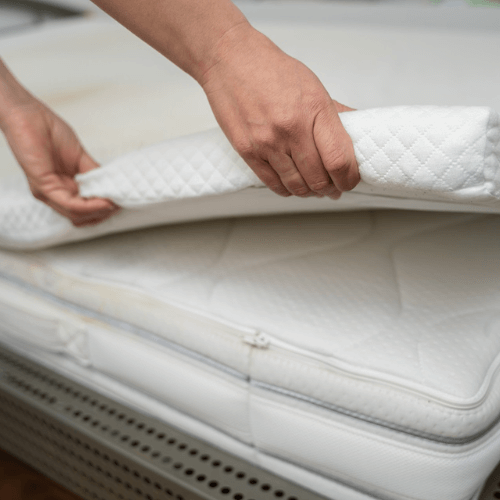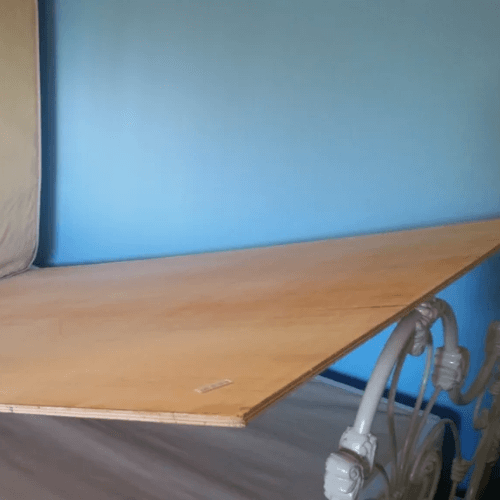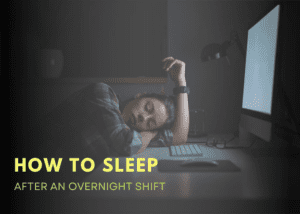Have you ever been woken up in the middle of the night by your partner’s tossing and turning? It’s a common problem that can be solved.
Reducing motion transfer in bed is easy and can help both partners get a better nights sleep.
You can reduce motion transfer by getting a quality memory foam mattress, otherwise you can follow the steps below like improving your bed frame with a bed bridge, plywood, and tightening up bolts. Also, if you sleep with a partner you can create a pillow and sheet barrier to reduce movement.
Here are some tips to help stop those pesky movements from disturbing you.
Identifying The Source Of Motion Transfer

A recent survey from the Sleep Foundation found that nearly 40% of couples reported sleeping inconsistently due to their partner’s movement.
Reducing motion transfer in bed can help couples sleep more soundly and awake feeling well-rested.
Here’s how:
Identifying the source of motion transfer is key. Many people assume a new mattress will solve any issue, but this isn’t always the case.
In fact, an old box spring or frame may be responsible for transferring more motion than a newer mattress.
If your current setup is more than seven years old, it’s time to take a closer look at the components.
Aging mattresses also contribute to motion transfer, especially if they’re made with innersprings since they don’t provide as much support over time.
Mattresses with foam cores are better at absorbing movement so those are worth considering when replacing your current mattress – but only after you’ve addressed any underlying frame issues first.
To get the best sleep possible, start by assessing what could be causing excess movement in your bed and replace any outdated items accordingly.
Choosing The Right Bed Frame And Mattress
Ah, the eternal dilemma. You want to sleep in peace and harmony, free from motion transfer. But how? Well my friends, fear not – I have the solution!
Let me introduce you to the magical combination of bed frame and mattress: the perfect recipe for reducing motion transfer. Here are some tips to help you get started:
- Choose a bed frame that won’t creak or wobble when you move around in your sleep.
- Look for mattresses that absorb movement, such as memory foam or hybrid models with pocket springs.
- Consider a slatted base for extra support and stability.
- Make sure the mattress can be flipped over for even wear.
- Look for beds with reinforced edges so the sides won’t sag over time.
No more tossing and turning – just blissful sleep without disruption from your partner’s movements!
Take these steps and you’ll be well on your way to achieving motionless nights of restful slumber.
Moving on…
Adding A Mattress Topper

Adding a mattress topper is another way to reduce motion transfer in bed. It can be placed directly on top of the mattress, creating an extra layer of padding and comfort.
Here are 4 key points to consider when adding a mattress topper:
- Make sure the mattress topper is compatible with your current sleeping setup.
- Choose the thickness and firmness that works best for your sleeping position and needs.
- Consider factors such as heat retention, breathability and durability when selecting a material like memory foam or latex.
- Look for certifications like CertiPUR-US® when shopping around for quality assurance.
A mattress topper can help reduce motion transfer while providing additional support and comfort.
It’s important to find a product that suits your individual needs and preferences, so you can get the restful sleep you deserve.
Next up is placing a memory foam layer under the mattress for further motion reduction.
Installing A Bed Bridge
Putting preventative measures in place can help reduce motion transfer in bed. Part of this process involves installing a bed bridge.
This savvy solution is simple, yet effective, when it comes to stabilizing the bed frame and minimizing movement.
A bed bridge is a small device that attaches to both sides of the bed frame and bridges the gap between them.
It’s made from sturdy materials such as wood or metal and can be adjusted for various sizes of beds.
While it does take some time to install, there are several benefits: it helps keep the mattress steady, prevents sagging and extends its lifespan.
Plus, it adds an extra layer of support for those who may experience back pain or discomfort when sleeping on soft mattresses.
TIP: Make sure to measure your mattress before purchasing a bed bridge so you can get an accurate fit – too small or too big won’t do! Installing locking wheels on the bed frame after attaching the bed bridge will further ensure that it stays still during sleep – no more tossing and turning!
Placing A Piece Of Plywood Under The Mattress

Putting a piece of plywood under the mattress is like building a bridge between two mountains.
It helps to reduce motion transfer in bed, creating a more solid foundation for people who share their sleeping space.
The plywood acts as an extra layer of support that absorbs movement, making it less noticeable and more comfortable for both sleepers.
Installing the plywood is relatively straightforward and requires only basic tools. After measuring the size of the bed frame, cut the plywood sheet to fit snugly within it.
Then place the sheet on top of the box spring or slats before laying down the mattress. Finally, secure it with screws or nails if necessary to ensure it stays in place while sleeping.
This simple solution can make a big difference in reducing motion transfer in bed, allowing both people to enjoy a good night’s rest without disruption.
It’s also relatively inexpensive so everyone can get their own peaceful oasis without breaking the bank. Furthermore, this method will help prolong mattress life by providing additional support and protection from wear and tear caused by movement.
As an added bonus, placing plywood under your mattress also helps to keep your sheets and blankets from slipping off!
Combating Motion Transfer With A Partner
Partnering up can be a great way to reduce motion transfer. When two people are in the same bed, their movements will tend to cancel each other out.
This is especially true if they both move at the same time in opposite directions.
The best way to achieve this is by sleeping in a spooning position with your partner as close to you as possible. This will also help keep you both warm through the night.
You can also use pillows and blankets to help reduce motion transfer.
Place them between you and your partner so that any movement will be absorbed by the pillow or blanket instead of being felt directly on your body.
You can also use body pillows or extra bedding around the edges of the bed to further dampen any movement that is felt from one side of the bed to the other.
This kind of setup can make for an incredibly comfortable sleep experience where neither partner’s movements disrupt the other’s rest.
With some experimentation, you and your partner should be able to find an arrangement that works for both of you and allows for a peaceful, undisturbed night’s sleep.
Frequently Asked Questions
What Type Of Mattress Should I Get To Reduce Motion Transfer?
If you’re looking for a peaceful night’s sleep, then forget about the mattress – just get yourself a concrete slab.
That’ll do the trick! Nothing quite like it to ensure you don’t feel your partner’s movements. It can be a bit hard on the back, but hey, at least you won’t be disturbed by any motion transfer.
But of course, if that doesn’t sound particularly appealing, then perhaps there are other options. A memory foam mattress is great for reducing motion transfer, since it contours to the body and absorbs movement from one side of the bed.
Not only will it provide comfort and support, but it’ll also keep disturbances to a minimum. Alternatively, if you want something bouncy yet supportive – look for hybrid mattresses with pocketed coils and foam layers.
This type of mattress creates an isolated sleeping surface that minimizes movement across the bed while providing just enough bounce for restful sleep.
So if your partner’s tossing and turning has been keeping you up all night long, try one of these options – they should help solve your problem so that you can finally get some restful shut-eye!
Conclusion
My conclusion is that reducing motion transfer in bed can be achieved with careful consideration of the mattress and topper you choose.
Memory foam layers tend to be more effective than mattress toppers as they absorb movement from your partner.
Additionally, if you have a larger mattress, locking wheels are beneficial for limiting motion transfer.
Finally, it’s important to remember that couples who sleep in separate beds are more likely to report higher levels of satisfaction with their relationship compared to those who share a bed.
So if you’re having trouble sleeping due to motion transfer, it may be time for a change!
I hope this article has provided insight into how you can reduce motion transfer in your own bed and enjoy a better night’s sleep.
I’m confident that with some research and careful consideration of your sleeping needs, you’ll be able to find the perfect mattress that will reduce motion transfer and enable both partners to get a great night’s rest.
After all, studies have shown that adults need seven or more hours of sleep every night in order to maintain optimal physical and mental health.
So don’t let motion transfer keep you from getting the restful sleep you deserve!





